Which radiators are better than aluminum or bimetallic
Heating equipment is manufactured by manufacturers from a variety of technological products. Sooner or later, everyone has a need to replace radiators, especially at the end of the heating season. The products are presented in a huge assortment both in terms of visual and technical characteristics. There are two main options in greatest demand: bimetallic and aluminum, the structure of which is in many ways similar, but has a number of differences. When choosing, many people are interested in which bimetallic or aluminum radiators are better and how they differ from each other. In this, and we will try to figure it out.
In order to make the right choice, you need to find out what is the working pressure of the coolant in the heating system of the house, since both options involve installation under different parameters. Each of them is designed for the permissible number of atmospheres and can withstand certain temperatures. For this, comparative characteristics are preliminarily studied. Experts say that bimetallic is best used in large buildings with central heating, and aluminum is suitable for low-rise buildings. But often many summer residents are limited by budgetary methods, and if an extreme increase in temperatures is not expected in the house, the pressure does not change, then they choose the option that is cheaper.
Experts know exactly which heating radiators are better - aluminum or bimetallic - video:
Reaction to the quality of the heating medium
Water acts as the main coolant in houses of any size and number of storeys. For aluminum radiators, it is not so much that it is dangerous as the impurities that are part of it, since they provoke the development of a corrosive process and the accumulation of lime deposits. For aluminum radiators, a pH value of more than 8 to 8 is especially critical.
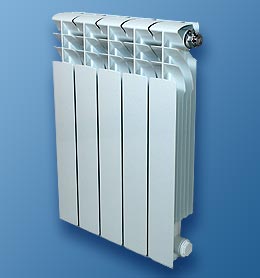
Aluminum is capable of releasing a chemical element - hydrogen, which is fraught with tearing out plugs and taps. To avoid such problems, it is necessary to periodically bleed air from the battery.
In a biometallic device, steel pipes are less whimsical to flowing water. Therefore, the susceptibility to corrosion is less significant. But it is impossible for oxygen to enter the water, as this also catalyzes the formation of rust. The advantage is high heat dissipation. It is noted that the section gives 200 watts of thermal energy, one part of which comes by convection, the other by radiation. Internal ribs provide high heat dissipation, which is incomparable with other types.
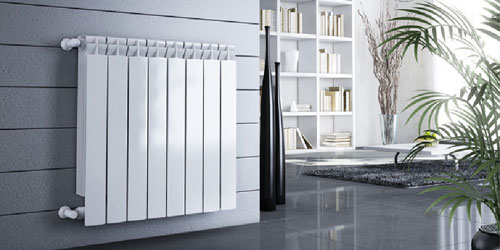
Bimetallic radiators are suitable for private houses where it is possible to regulate the heating on / off periods. The room heats up literally within 10 minutes.
In bimetallic radiators, heat is transferred from the sections. The steel core reduces the overall heat dissipation, so it is lower. Thermal inertia is also not large.
Comparative advantages
To determine the question of which radiators are better - bimetallic or aluminum, many consumers seek professional advice, while studying the detailed distinctive features.
For example, aluminum equipment has a more stylish, neat look. Such radiators consist of several sections connected by nipples. The structure is made by extrusion of a section of aluminum alloy with a silicon additive under high pressure.
![]()
They differ among themselves in the manufacturing method, as:
- cast,
- separate sections,
- sectional (extrusion) bolted.
In the latter version, sealing is performed with silicone or other materials. The location of the fins on the inside gives an increase in the heat dissipated area of up to 0.5 m². Reliability is also determined by the manufacturer.
The extrusion method is characterized by low quality, cheap and easy-to-manufacture products. The cast structure is considered to be more durable.
The production of a bimetallic radiator is carried out using two types of metal - aluminum and steel. Aluminum alloy is used for the ribbed casing. Robust steel and sleek aluminum combine high reliability.
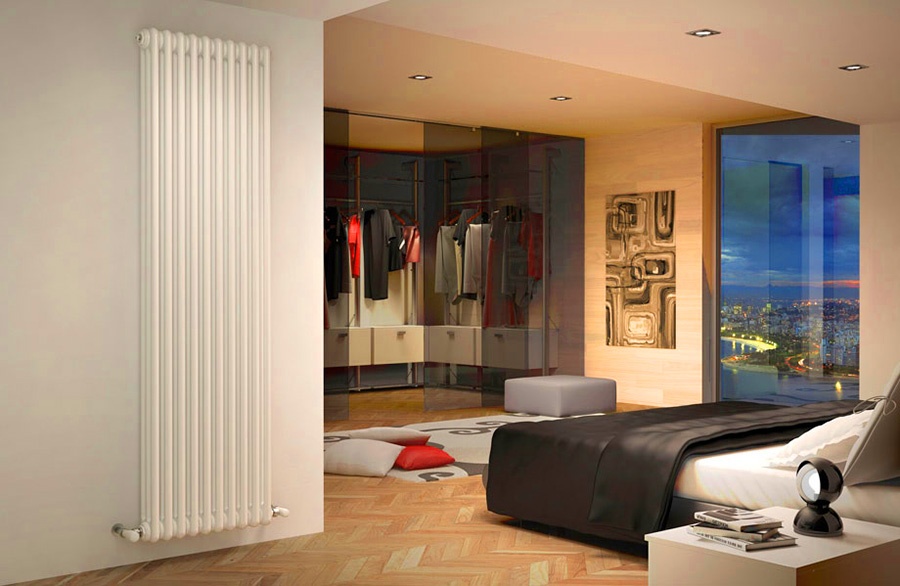
The core (inner part), through which the hot water flows, is made of copper or steel. On the outside it is a flat panel, on the inside there is ribbing. The pipe diameter is smaller, which contributes to early clogging. Design, appearance, compact dimensions are aesthetically pleasing, satisfying the refined tastes of the consumer. All steel components are located inside the structure.
General characteristics and disadvantages
Aluminum
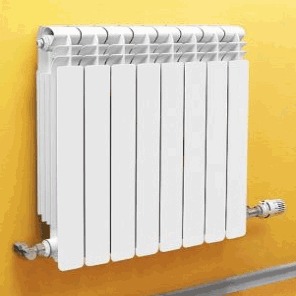
Aluminum elements are characterized in terms of pressure, temperature, heat transfer rate. Modern aluminum equipment withstands a pressure of 6-20 atm., Which is used in standard apartments and country houses. Withstands temperature heating up to 130 degrees. The fastest room heating due to high heat transfer. Possibility to install in various rooms due to its aesthetic design.
The disadvantages include problematic installation due to water hammer in the system of an apartment building. But manufacturers produce more expensive reinforced models that can withstand, among other things, strong pressures of water. Copper fittings and aluminum during a chemical reaction create gas formation inside, which are removed by specially installed automatic air vents. Leakage may occur between sections. Differs in weak anti-corrosion resistance.
Bimetallic
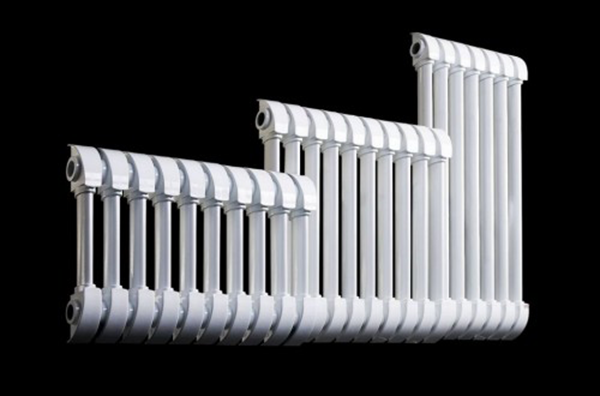
The synthetic properties of steel and aluminum are combined in a biometallic structure, which is determined by the indicators of pressure, corrosion, heat transfer, and a design solution. The structure withstands more than 90 atmospheres of burst pressure, and the core is capable of withstanding 20 to 40 atmospheres of operating pressure in the coolant. Due to the aluminum coating, heat transfer is achieved (170-190 W). Also, thanks to steel (and in some models the core is made of stainless steel), they have high anti-corrosion performance and are durable. Exquisite design and variety in some models are able to satisfy the most demanding consumer. The equipment can serve for more than 20 years, while maintaining aesthetic and technical indicators.
The disadvantages include:
- a lower volume of coolant, which can lead to an emergency while saving money for the operation of boiler equipment;
- when the heating is turned off, the air in the room instantly cools;
- high price.
It is important to note that there are varieties of this type of equipment, depending on the material of manufacture. Steel pipes are cheaper than copper pipes. The use of structures with copper pipes is possible in heating devices with copper elements. Between themselves, they are divided into monolithic and sectional. In a monolithic, the inner pipe has a fixed length, withstands up to 100 atm.
The most popular are sectional. Their main advantage is that the sections can always be removed by adjusting the power. They are suitable for a private house and apartment. Water for heating passes through them fewer times than in other designs.
Based on this information, you should first of all decide on the individual characteristics, while paying attention to the features of the installation. The considered products are comfortable to install. Even drywall can withstand their weight. Installation with plastic pipes is carried out with a set of keys, shaped tools. Bimetallic ones are not subject to deformation, which makes them different from soft aluminum. They are also considered to be stronger, more durable, able to withstand high pressure. The difference in metals can create reactions, causing gassing, as in the other type.
In aluminum radiators, thermal conductivity is higher, the price is lower, and the weight is less. It is preferable to install them in a private house where a boiler operates with a constant low pressure and no pressure surges. At the same time, the water is cleaner, without impurities with a constantly stable temperature. Such batteries will work well for a long time. Most modern equipment manufacturers, including domestic ones, pay attention to the quality composition and level of water pollution in heating.
Particularly noteworthy is the quality of tightness, which is ensured by reliable gaskets and the absence of pockets where gases and sludge do not accumulate, which provokes the development of corrosion.
